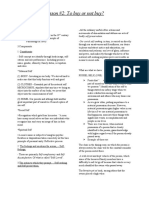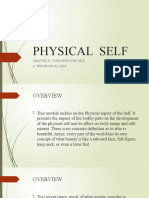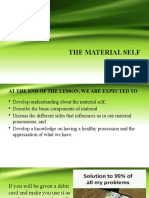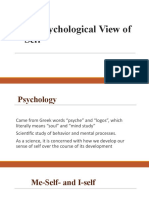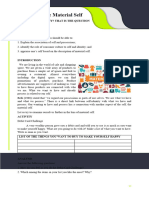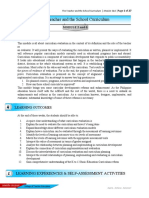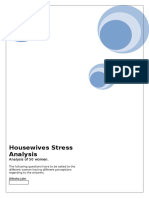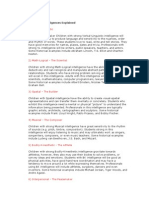To Buy or Not To Buy? That Is The Question!: Learning Experiences & Self-Assessment Activities (Saa)
To Buy or Not To Buy? That Is The Question!: Learning Experiences & Self-Assessment Activities (Saa)
Uploaded by
Jeremias De la CruzCopyright:
Available Formats
To Buy or Not To Buy? That Is The Question!: Learning Experiences & Self-Assessment Activities (Saa)
To Buy or Not To Buy? That Is The Question!: Learning Experiences & Self-Assessment Activities (Saa)
Uploaded by
Jeremias De la CruzOriginal Title
Copyright
Available Formats
Share this document
Did you find this document useful?
Is this content inappropriate?
Copyright:
Available Formats
To Buy or Not To Buy? That Is The Question!: Learning Experiences & Self-Assessment Activities (Saa)
To Buy or Not To Buy? That Is The Question!: Learning Experiences & Self-Assessment Activities (Saa)
Uploaded by
Jeremias De la CruzCopyright:
Available Formats
To Buy or Not To Buy? That is the Question!
|1
TO BUY OR NOT TO BUY? THAT IS THE QUESTION!
MODULE 6
OVERVIEW
We are living in a world of sale and shopping spree. We are given a wide array of products to
purchase from a simple set of spoon and fork to owning a restaurant. Almost everywhere, including the
digital space, we can find promotions of product purchase. Product advertisements are suggestive of making
us feel better or look good. Part of us wants to have that product. What makes us want to have those products
are connected with who we are. What we want to have and already possess is related to our self. Belk
(1988) stated that "we regard our possessions as parts of our selves. We are what we have and what we
possess." There is a direct link between self- identity with what we have and possess. Our wanting to have
and possess has a connection with another aspect of the self, the material self. Let us try to examine
ourselves further in the lens of material self.
LEARNING OUTCOMES
✓ explain the association of self and possessions;
✓ identify the role of consumer culture to self and identity; and
✓ appraise one's self based on the description of material self
LEARNING EXPERIENCES & SELF-ASSESSMENT ACTIVITIES (SAA)
ACTIVITY:
Debit Card Challenge
A very wealthy person gave you a debit card and told you to use it as much as you want to make
yourself happy. What are you going to do with it? Make a list of what you want to have. Write as many as
you want.
ANALYSIS:
Answer the following questions:
1. How do you feel as you do the Debit Card Challenge?
2. Which among the items in your list you like the most? Why?
3. If ever you were given the chance in real life to have one among the list, which would you
choose? Why?
4. Does your choices different from what you answer in question number 2? Why or why not?
ABSTRACTION
Material Self
A Harvard psychologist in the late nineteenth century, William James, wrote in his book, The Principles
of Psychology in 1890 that understanding the self can be examined through its different components. He
described these components as: (1) its constituents; (2) the feelings and emotions they arouse—self-
feelings; (3) the actions to which they prompt—self-seeking and self-preservation. The constituents of
self are composed of the material self, the social self, the spiritual self and the pure ego. (Trentmann 2016;
Green 1997)
OSMEÑA COLLEGES College of Teacher Education
Aspire…Achieve…Advance!
To Buy or Not To Buy? That is the Question! |2
The material self, according to James primarily is about our bodies, clothes, immediately family,
and home. We are deeply affected by these things because we have put much investment of our self to them.
SELF
Body
Clothes
Immediate family
Home
Material Self Investment Diagram
(First) The innermost part of our material self is our body. Intentionally, we are investing in our
body. We are directly attached to this commodity that we cannot live without. We strive hard to make sure
that this body functions well and good. Any ailment or disorder directly affects us. We do have certain
preferential attachment or intimate closeness to certain body parts because of its value to us.
There were people who get their certain body parts insured. Celebrities, like Mariah Carey who
was reported to have placed a huge amount for the insurance of her vocal cords and legs (Sukman 2016).
(Second) Next to our body are the clothes we use. Influenced by the "Philosophy of Dress" by
Herman Lotze, James believed that clothing is an essential part of the material self. Lotze in his book,
Microcosmus, stipulates that "any time we bring an object into the surface of our body, we invest that object
into the consciousness of our personal existence taking in its contours to be our own and making it part of
the self." (Watson 2014) The fabric and style of the clothes we wear bring sensations to the body to which
directly affect our attitudes and behavior. Thus, clothes are placed in the second hierarchy of material self.
Clothing is a form of self-expression. We choose and wear clothes that reflect our self (Watson 2014).
Third in the hierarchy is our immediate family. Our parents and siblings hold another great
important part of our self. What they do or become affects us. When an immediate family member dies,
part of our self-dies, too. When their lives are in success, we feel their victories as if we are the one holding
the trophy. In their failures, we are put to shame or guilt. When they are in disadvantage situation, there is
an urgent urge to help like a voluntary instinct of saving one's self from danger. We place huge investment
in our immediate family when we see them as the nearest replica of our self.
The fourth component of material self is our home. Home is where our heart is. It is the earliest
nest of our selfhood. Our experiences inside the home were recorded and marked on particular parts and
things in our home. There was an old cliché about rooms: "if only walls can speak." The home thus is an
extension of self, because in it, we can directly connect our self. Having investment of self to things, made
us attached to those things. The more investment of self-given to the particular thing, the more we identify
ourselves to it. We also tended to collect and possess properties. The collections in different degree of
investment of self, becomes part of the self. As James (1890) described self: "a man's self is the sum total
of all what he CAN call his." Possessions then become a part or an extension of the self.
We Are What We Have
Russel Belk (1988) posits that "...we regard our possessions as part of ourselves. We are what we have and
what we possess." The identification of the self to things started in our infancy stage when we make a
distinction among self and environment and others who may desire our possessions. As we grow older,
putting importance to material possession decreases. However, material possession gains higher value in
our lifetime if we use material possession to find happiness, associate these things with significant events,
accomplishments, and people in our lives. There are even times, when material possession of a person that
OSMEÑA COLLEGES College of Teacher Education
Aspire…Achieve…Advance!
To Buy or Not To Buy? That is the Question! |3
is closely identified to the person, gains acknowledgment with high regard even if the person already passed
away. Examples of these are the chair in the dining room on which the person is always seated, the chair
will be the constant reminder of the person seated there; a well-loved and kept vehicle of the person, which
some of the bereaved family members have a difficulty to sell or let go of because that vehicle is very much
identified with the owner who passed away; the favorite pet or book, among others that the owner placed a
high value, these favorite things are symbols of the owner. The possessions that we dearly have tell
something about who we are, our self-concept, our past, and even our future.
APPLICATION:
Debit Card Challenge List
• Go back to your Debit Card Challenge List. Put a mark on the left side of each item with the following
categories:
B --- if the item is related with your body
C — if the item is related with clothes
F — if the item is related or intended to your family
H — if the item is related with home
2. Answer the following questions:
• Which among the categories you have the most in your list?
• What do you think these things tell you about yourself?
SELF-ASSESSMENT ACTIVITIES (SAA) SHEET
ACTIVITY
ANALYSIS
1. _________________________________________________________________________________
_________________________________________________________________________________
_________________________________________________________________________________
_________________________________________________________________________________
2. _________________________________________________________________________________
_________________________________________________________________________________
_________________________________________________________________________________
3. _________________________________________________________________________________
_________________________________________________________________________________
_________________________________________________________________________________
_________________________________________________________________________________
OSMEÑA COLLEGES College of Teacher Education
Aspire…Achieve…Advance!
To Buy or Not To Buy? That is the Question! |4
4. _________________________________________________________________________________
_________________________________________________________________________________
_________________________________________________________________________________
APPLICATION
1.
2.
• _________________________________________________________________________________
_________________________________________________________________________________
_________________________________________________________________________________
_________________________________________________________________________________
• _________________________________________________________________________________
_________________________________________________________________________________
_________________________________________________________________________________
_________________________________________________________________________________
REFERENCES
Glietman, Henry, James Gross, and Daniel Reisberg. 2011. Psychology. 8 th Ed. Canada:W.W. Norton and
Company
Qingxue, Liu. 2003. “Understanding Different Patterns or Orientations Between East and West.”
Investigationes Linguisticae. Vol. IX. April 2003. Accessed October 14, 2017.
https://www.staff.amu.edu.pl/~inveling/pgf/liu
-quingxue_inve9.pdf.
OSMEÑA COLLEGES College of Teacher Education
Aspire…Achieve…Advance!
To Buy or Not To Buy? That is the Question! |5
END OF MODULE ASSESSMENT
(Please do not forget to provide information on this part)
Name: _____________________________________________ Course& Year:_____________
Module Number and Title: ______________________________________________________
Contact number & email (if any):_______________________________
Date accomplished: ________________________
Now that you have finished the review of the various concepts outlined above, it is now time for an
assessment to see how far you have improved. Write your answers on the blank space provided for
each question.
A. True or False.
Write the TRUE if the statement is correct, and write FALSE if the statement is incorrect. Write
your answers on the space provided. (These items include the whole Chapter)
_____________ 1. The material self, according to James primarily is about our bodies, clothes,
immediately family, and home.
_____________ 2. The innermost part of our material self is our clothes we wear.
_____________ 3. The constituents of self are composed of the material self, the social self, the
spiritual self and the pure ego.
_____________ 4. A Harvard psychologist in the late nineteenth century, William James, wrote
in his book, The Principles of Psychology in 1990.
_____________ 5. The third in the hierarchy of material self is our immediate family.
_____________ 6. According to James that understanding the self cannot be examined through
its different components.
_____________ 7. Clothing is a form of self-expression.
_____________ 8. The second innermost part of our material self is our body.
_____________ 9. The fourth component of material self is our home.
_____________ 10.School is where our heart is. It is the earliest nest of our selfhood.
B. Describe these lines “We Are What We Have” in your own understanding not less than 100 words.
(5 points)
_____________________________________________________________________________________
_____________________________________________________________________________________
_____________________________________________________________________________________
_____________________________________________________________________________________
_____________________________________________________________________________________
_____________________________________________________________________________________
_____________________________________________________________________________________
_____________________________________________________________________________________
_____________________________________________________________________________________
_____________________________________________________________________________________
_____________________________________________________________________________________
_____________________________________________________________________________________
_____________________________________________________________________________________
_____________________________________________________________________________________
OSMEÑA COLLEGES College of Teacher Education
Aspire…Achieve…Advance!
To Buy or Not To Buy? That is the Question! |6
LOOKING AHEAD
Congratulations for making it till the end of this module! If you aced the assessments, I am happy
for you. If you have not reached your desired level of competence, just keep going! Remember that an
expert was once a beginner. The next topic will deal on the “SUPERNATURALS, BELIEVE IT OR NOT”
Happy learning!
SELF AND MODULE EVALUATION
This part requires you to rate the quality of the module to help you continuously improve the
development of this learning module. This also asks you to rate your learning experience for each of the
modules. Rate the module using the following:
1 - Strongly disagree
2 - Disagree
3 - Agree
4 - Strongly agree
The learning module 1 2 3 4
Please check the appropriate column.
was engaging
allowed for self-checking (SAAs)
developed in gradual, manageable steps
provided independent, self-paced learning
contained relevant information I needed
SELF-EVALUATION
Rate the extent of your learning in this module using the scale below. Check the column
corresponding to your rating in the space provided. Do not hesitate to contact me if you need further
assistance.
4 - I’m an expert. I understand and can teach a friend about it.
3 - I’m a Practioner. I understand and can cite examples on the topics given.
2 - I’m an apprentice. I understand if I get help or look at more examples.
1 - I’m a novice. I do not understand the topic.
My Learning: 1 2 3 4
I can now
Please check the appropriate column.
explain the association of self and possessions;
identify the role of consumer culture to self and identity; and
appraise one's self based on the description of material self
OSMEÑA COLLEGES College of Teacher Education
Aspire…Achieve…Advance!
You might also like
- Exploring Philosophical PerspectivesDocument26 pagesExploring Philosophical PerspectivesJhunalie Vega NavalNo ratings yet
- Material SelfDocument19 pagesMaterial SelfAza ChōbeiNo ratings yet
- Introduction To The Physical SelfDocument5 pagesIntroduction To The Physical SelfMaika Narciso100% (2)
- Lesson Self, Society, and CultureDocument8 pagesLesson Self, Society, and Culturebrice burgos73% (11)
- Physical Self Image MatterDocument72 pagesPhysical Self Image MatterMark225user100% (2)
- Uts ReviewerDocument5 pagesUts Reviewerc100% (1)
- Detailed Lesson Plan in Number Theory (2Nd Year) July 2, 2021 1 HourDocument4 pagesDetailed Lesson Plan in Number Theory (2Nd Year) July 2, 2021 1 HourJeremias De la Cruz100% (1)
- BSU SOWK 300 Stages of Developmentt Spring 2011 ONLINEDocument12 pagesBSU SOWK 300 Stages of Developmentt Spring 2011 ONLINEFlorence OlatunjiNo ratings yet
- M8L4 Conflict Management QuestionnaireDocument3 pagesM8L4 Conflict Management QuestionnaireSilvana ElenaNo ratings yet
- The-Material-Self (1) For StudentsDocument19 pagesThe-Material-Self (1) For StudentsFerl Diane SiñoNo ratings yet
- To Buy or Not To Buy? That Is The Question!: Chapter 2 Lesson 2Document12 pagesTo Buy or Not To Buy? That Is The Question!: Chapter 2 Lesson 2Crisell Jane Gallarde AngobNo ratings yet
- The Spiritual Self UTSDocument32 pagesThe Spiritual Self UTSJulia Ferolino100% (3)
- Lesson #2: To Buy or Not Buy?: Bodily Self-PreservationDocument2 pagesLesson #2: To Buy or Not Buy?: Bodily Self-PreservationGilyn NaputoNo ratings yet
- Psychology - The Self As Cognitive ConstructionDocument13 pagesPsychology - The Self As Cognitive ConstructionRalph Torres100% (1)
- Understanding The Self Module 2Document4 pagesUnderstanding The Self Module 2Guki SuzukiNo ratings yet
- Chapter 2-Understanding The SelfDocument31 pagesChapter 2-Understanding The SelfclarenceNo ratings yet
- The Self, Society, and Culture: ObjectivesDocument11 pagesThe Self, Society, and Culture: ObjectivesKent Remar Cuñado0% (1)
- To Buy or Not To Buy : That Is The Question!Document10 pagesTo Buy or Not To Buy : That Is The Question!Marjhon TubillaNo ratings yet
- The Self As Cognitive Construct: Learning Experiences & Self-Assessment Activities (Saa)Document9 pagesThe Self As Cognitive Construct: Learning Experiences & Self-Assessment Activities (Saa)Jeremias De la CruzNo ratings yet
- Frankl's Sources of MeaningDocument12 pagesFrankl's Sources of MeaningJessica Kaye Durana100% (3)
- UtsDocument11 pagesUtsAnonymous mllFMbsA71No ratings yet
- Learning Objectives: Module 1 - Physical SelfDocument4 pagesLearning Objectives: Module 1 - Physical SelfMiss MegzzNo ratings yet
- Physical Self: Chapter Ii: Unpacking The Self A. The Physical SelfDocument35 pagesPhysical Self: Chapter Ii: Unpacking The Self A. The Physical SelfCherry Mae CabuangNo ratings yet
- Chapter 2 Sociological PerspectiveDocument15 pagesChapter 2 Sociological PerspectiveStephanie CapistranoNo ratings yet
- MATERIAL SELF - Learning Guide - FinalDocument6 pagesMATERIAL SELF - Learning Guide - FinalRhea Antonette Mancao BaylonNo ratings yet
- Physical SelfDocument2 pagesPhysical SelfJhon Marvin Arienza100% (1)
- Lesson 6 - The Physical SelfDocument2 pagesLesson 6 - The Physical SelfmichelleNo ratings yet
- Module 2 - SOCIOLOGICAL PERSPECTIVE OF THE SELFDocument4 pagesModule 2 - SOCIOLOGICAL PERSPECTIVE OF THE SELFJemuel Bucud Lagarto100% (1)
- GEC 1 Lesson 6 The Material SelfDocument32 pagesGEC 1 Lesson 6 The Material SelfTomi tandog79% (19)
- Lesson 3Document10 pagesLesson 3Sherilyn C. Dela Cruz80% (5)
- Material Self: Module #3: Unpacking The SelfDocument30 pagesMaterial Self: Module #3: Unpacking The SelfRephraimNo ratings yet
- The Material SelfDocument26 pagesThe Material SelfJEAN PAULYN MUSNINo ratings yet
- Chapter 4 The-Spiritual-SelfDocument39 pagesChapter 4 The-Spiritual-SelfCrl Phlp50% (2)
- CHAPTER 2 Lesson 2 To Buy or Not To Buy That Is The QuestionDocument12 pagesCHAPTER 2 Lesson 2 To Buy or Not To Buy That Is The QuestionLmao xd100% (4)
- Unpacking The Self - Physical and Sexual SelfDocument26 pagesUnpacking The Self - Physical and Sexual SelfDero100% (2)
- Word-2.6 - The Political SelfDocument2 pagesWord-2.6 - The Political Selfmamimomasheshe100% (2)
- Lesson 3 Module 3: Values Development For Citizenship TrainingDocument5 pagesLesson 3 Module 3: Values Development For Citizenship TrainingAnamae Detaro DarucaNo ratings yet
- Primary - Not Made or Coming From Something Else, Original Firsthand - Coming Directly From The Original SourceDocument2 pagesPrimary - Not Made or Coming From Something Else, Original Firsthand - Coming Directly From The Original SourceKarenjoy Rosal DeveraNo ratings yet
- Chapter Iii: Managing and Caring For The Self C. Taking Charge of One'S HealthDocument11 pagesChapter Iii: Managing and Caring For The Self C. Taking Charge of One'S Healthzed cozNo ratings yet
- Anthropological SelfDocument2 pagesAnthropological SelfEffie CollinsNo ratings yet
- The Self in Western and Eastern ThoughtsDocument14 pagesThe Self in Western and Eastern ThoughtsJustien BautistaNo ratings yet
- Lesson 2: The Self, Society, and CultureDocument8 pagesLesson 2: The Self, Society, and Cultureryan100% (3)
- GEC 1 Lesson 6 The Material SelfDocument32 pagesGEC 1 Lesson 6 The Material SelfbuttewcupzNo ratings yet
- The Psychological View of SelfDocument29 pagesThe Psychological View of SelfMiggy BaluyutNo ratings yet
- For Me, Beauty Means Appreciating Those Qualities in Ourselves, Being Comfortable OnDocument2 pagesFor Me, Beauty Means Appreciating Those Qualities in Ourselves, Being Comfortable OnChristine Joy PacheoNo ratings yet
- Unit Ii Unpacking Self: Module 6 The Physical SelfDocument34 pagesUnit Ii Unpacking Self: Module 6 The Physical SelfAnna Jean Tejada - CapillanNo ratings yet
- Understanding The Self: Course Code: UNDSELFDocument17 pagesUnderstanding The Self: Course Code: UNDSELFDianna Rose DiazNo ratings yet
- Finding Creating Meaning of LifeDocument13 pagesFinding Creating Meaning of LifeMelizza Fajardo Bañano100% (2)
- Three Ways of Discovering Meaning of LifeDocument4 pagesThree Ways of Discovering Meaning of LifePineda ARIESNo ratings yet
- Understanding The Self 1 PDFDocument14 pagesUnderstanding The Self 1 PDFPrincess BarteNo ratings yet
- Module 6 - The Physical SelfDocument18 pagesModule 6 - The Physical SelfRoseNo ratings yet
- The Self From Various Philosophical Perspectives 2Document27 pagesThe Self From Various Philosophical Perspectives 2Jaypee de GuzmanNo ratings yet
- CHAPTER 2 Lesson 3 - Supernaturals - Believe It or NotDocument15 pagesCHAPTER 2 Lesson 3 - Supernaturals - Believe It or NotGiscele Sierra100% (1)
- Midterm Exam in UtsDocument3 pagesMidterm Exam in Utsclay adrianNo ratings yet
- NSTPDocument10 pagesNSTPRodel Delos ReyesNo ratings yet
- Chapter 3 An Anthropological Conceptualization of Self The Self As Embedded in CultureDocument5 pagesChapter 3 An Anthropological Conceptualization of Self The Self As Embedded in CulturePearl Necole100% (1)
- History Was Derived From The Greek Word "Historia" Which Means "Knowledge Acquired Through Inquiry or Investigation"Document3 pagesHistory Was Derived From The Greek Word "Historia" Which Means "Knowledge Acquired Through Inquiry or Investigation"kernelkobieNo ratings yet
- Emotional SelfDocument15 pagesEmotional Selfgallegosnicholai100% (2)
- Self and Filipino Society and VolunteerismDocument58 pagesSelf and Filipino Society and VolunteerismAsy MNNo ratings yet
- The Spiritual SelfDocument5 pagesThe Spiritual SelfMichelle LomaNo ratings yet
- Ge01 Module 60Document6 pagesGe01 Module 60Warters PainsNo ratings yet
- Legacy College of Compostela: First ModuleDocument4 pagesLegacy College of Compostela: First ModulePhilip Pippo BuonoNo ratings yet
- Handout For Material SelfDocument4 pagesHandout For Material Selfangelaeveherrera15No ratings yet
- The Self in Western and Eastern Thoughts: Learning Experiences & Self-Assessment Activities (Saa)Document7 pagesThe Self in Western and Eastern Thoughts: Learning Experiences & Self-Assessment Activities (Saa)Jeremias De la CruzNo ratings yet
- The Self As Cognitive Construct: Learning Experiences & Self-Assessment Activities (Saa)Document9 pagesThe Self As Cognitive Construct: Learning Experiences & Self-Assessment Activities (Saa)Jeremias De la CruzNo ratings yet
- The Physical and Sexual Self: Learning Experiences & Self-Assessment Activities (Saa)Document12 pagesThe Physical and Sexual Self: Learning Experiences & Self-Assessment Activities (Saa)Jeremias De la CruzNo ratings yet
- The Self, Society, and Culture - Page 1 of 11Document11 pagesThe Self, Society, and Culture - Page 1 of 11Jeremias De la CruzNo ratings yet
- Unit 1 - Lesson 1 Mathematics in Ancient EgyptDocument17 pagesUnit 1 - Lesson 1 Mathematics in Ancient EgyptJeremias De la CruzNo ratings yet
- Technology For Teaching and Learning 1: MC Allied 2 SF/ Profed 08heDocument8 pagesTechnology For Teaching and Learning 1: MC Allied 2 SF/ Profed 08heJeremias De la CruzNo ratings yet
- Technology: Boon or Bane: Learning Experiences & Self-Assessment Activities (Saa)Document6 pagesTechnology: Boon or Bane: Learning Experiences & Self-Assessment Activities (Saa)Jeremias De la CruzNo ratings yet
- What, Why and How To Evaluate A CurriculumDocument32 pagesWhat, Why and How To Evaluate A CurriculumJeremias De la CruzNo ratings yet
- Portfolio Assessment Methods: Learning Experiences & Self-Assessment Activities (Saa)Document11 pagesPortfolio Assessment Methods: Learning Experiences & Self-Assessment Activities (Saa)Jeremias De la CruzNo ratings yet
- Technology For Teaching and Learning 1: Prof Educ 8heDocument7 pagesTechnology For Teaching and Learning 1: Prof Educ 8heJeremias De la Cruz100% (1)
- MC Math 20 Instrumentation of Mathematics Prelim Examination SY: 2020-2021/ 2 SemesterDocument8 pagesMC Math 20 Instrumentation of Mathematics Prelim Examination SY: 2020-2021/ 2 SemesterJeremias De la CruzNo ratings yet
- The Roles of Educational Technology in Learning: Learning Experiences & Self-Assessment Activities (Saa)Document6 pagesThe Roles of Educational Technology in Learning: Learning Experiences & Self-Assessment Activities (Saa)Jeremias De la CruzNo ratings yet
- Prof EdDocument29 pagesProf EdJeremias De la CruzNo ratings yet
- Technology For Teaching and Learning 1: MC Allied 2 SF/ Profed 08heDocument9 pagesTechnology For Teaching and Learning 1: MC Allied 2 SF/ Profed 08heJeremias De la CruzNo ratings yet
- Technology For Teaching and Learning 1: MC Allied 2 SF/ Profed 08heDocument9 pagesTechnology For Teaching and Learning 1: MC Allied 2 SF/ Profed 08heJeremias De la CruzNo ratings yet
- Prof Ed 9 ModuleDocument27 pagesProf Ed 9 ModuleJeremias De la CruzNo ratings yet
- Technology For Teaching and Learning 1: MC Allied 2 SF/ Profed 08heDocument10 pagesTechnology For Teaching and Learning 1: MC Allied 2 SF/ Profed 08heJeremias De la CruzNo ratings yet
- "Effects of Blended Learning Approach To The Students' Performance in Osmeña Colleges, Teacher of Education DepartmentDocument5 pages"Effects of Blended Learning Approach To The Students' Performance in Osmeña Colleges, Teacher of Education DepartmentJeremias De la CruzNo ratings yet
- Prof Ed 9 - Prelim Module - AnswersDocument6 pagesProf Ed 9 - Prelim Module - AnswersJeremias De la Cruz100% (2)
- A Detailed Lesson Plan in EnglishDocument7 pagesA Detailed Lesson Plan in EnglishJeremias De la Cruz0% (1)
- Motivation WikipediaDocument20 pagesMotivation WikipediabrienahNo ratings yet
- Online AssignmentDocument10 pagesOnline AssignmentceebjaerNo ratings yet
- FiltersDocument15 pagesFiltersSuellen CruzalNo ratings yet
- Practice Research 1Document6 pagesPractice Research 1mama.jalal032606No ratings yet
- Modern Methods of Performance Appraisal by Anshul AryaDocument18 pagesModern Methods of Performance Appraisal by Anshul AryaHardik KothiyalNo ratings yet
- Social Stories and Young Children - Strategies For Teachers (2012)Document8 pagesSocial Stories and Young Children - Strategies For Teachers (2012)SarahNo ratings yet
- Nursing Care of Children Principles and Practice 4th Edition James Test BankDocument5 pagesNursing Care of Children Principles and Practice 4th Edition James Test BankCherokee100% (2)
- Essay(s)Document4 pagesEssay(s)fadya faradibaNo ratings yet
- Chapter 1 IIIDocument7 pagesChapter 1 IIILexter MolleraNo ratings yet
- LynchT R TrostW T SalsmanN LinehanM M 2007DBTforBPDDocument28 pagesLynchT R TrostW T SalsmanN LinehanM M 2007DBTforBPDPriyanka RastogiNo ratings yet
- HR Trends For 2022 - Future of Human Resource ManagementDocument30 pagesHR Trends For 2022 - Future of Human Resource ManagementfahiraNo ratings yet
- Professionalism in ECEDocument12 pagesProfessionalism in ECENamrataNo ratings yet
- Seballos, Xavier Louis D. - MRR1 - Self and IdentityDocument3 pagesSeballos, Xavier Louis D. - MRR1 - Self and IdentityXavier Louis Diosana SeballosNo ratings yet
- Case Study On Behavioural Problem in PreDocument4 pagesCase Study On Behavioural Problem in PreAditi SinghNo ratings yet
- Political Culture LectureDocument19 pagesPolitical Culture Lectureblue_july2000100% (3)
- Soc 315Document6 pagesSoc 315KEHINDE BABALOLANo ratings yet
- Criminology Chicago School Symbolic Interactionism School: Frederic M. ThrasherDocument6 pagesCriminology Chicago School Symbolic Interactionism School: Frederic M. ThrasherSaahiel SharrmaNo ratings yet
- Barrowcliff EM Diminish Arousal BritJClinPsychol 2003Document14 pagesBarrowcliff EM Diminish Arousal BritJClinPsychol 2003Felipe Orejuela SotoNo ratings yet
- Housewives Stress AnalysisDocument8 pagesHousewives Stress AnalysisvivekNo ratings yet
- Barrett Values Centre: Personal Values Assessment Megenila GuillenDocument8 pagesBarrett Values Centre: Personal Values Assessment Megenila GuillenlinelljoieNo ratings yet
- Aston Kuta Hotel & Residence: HRD ManagerDocument1 pageAston Kuta Hotel & Residence: HRD ManagerogynugrahNo ratings yet
- Community Health Nursing Final Exam (Total Marks 80) I-Choose The Best Answers: - (25 Marks)Document10 pagesCommunity Health Nursing Final Exam (Total Marks 80) I-Choose The Best Answers: - (25 Marks)Sukumari ImmadiNo ratings yet
- 8 Multiple IntelligencesDocument2 pages8 Multiple IntelligencesEli NurlaeliNo ratings yet
- CH 1 Organizational BehaviourDocument25 pagesCH 1 Organizational BehaviourRishabh JainNo ratings yet
- The Exley Chemical Case AnalysisDocument5 pagesThe Exley Chemical Case AnalysisHou RasmeyNo ratings yet
- Psy210 Psy2105 Fernandez SemestralDocument1 pagePsy210 Psy2105 Fernandez SemestralBernardNo ratings yet
- Training - Human Resource ManagementDocument26 pagesTraining - Human Resource ManagementRahul KhannaNo ratings yet
- 4862 Assgnmnt1Document20 pages4862 Assgnmnt1Mellinco Ramokolo100% (2)












